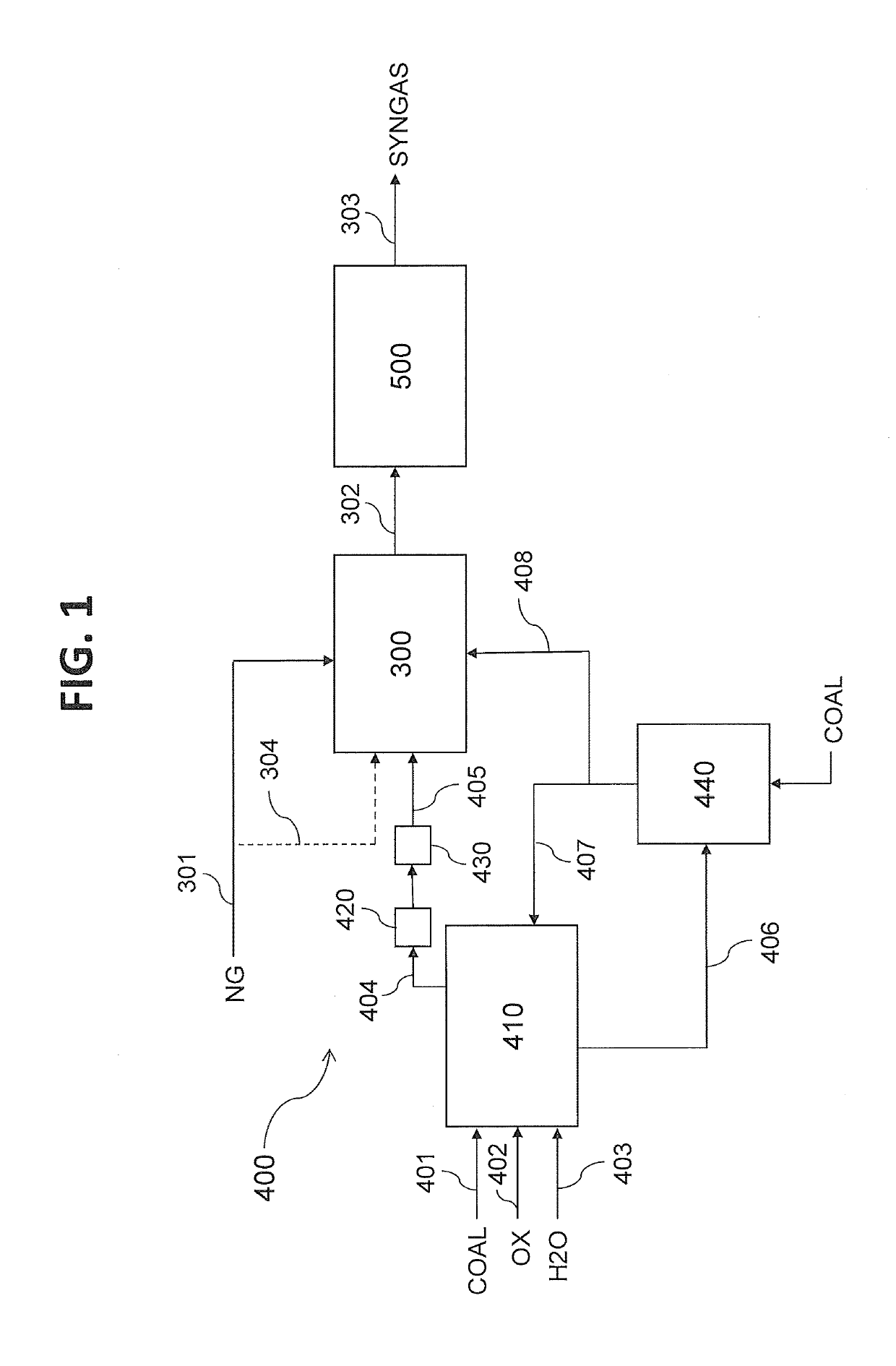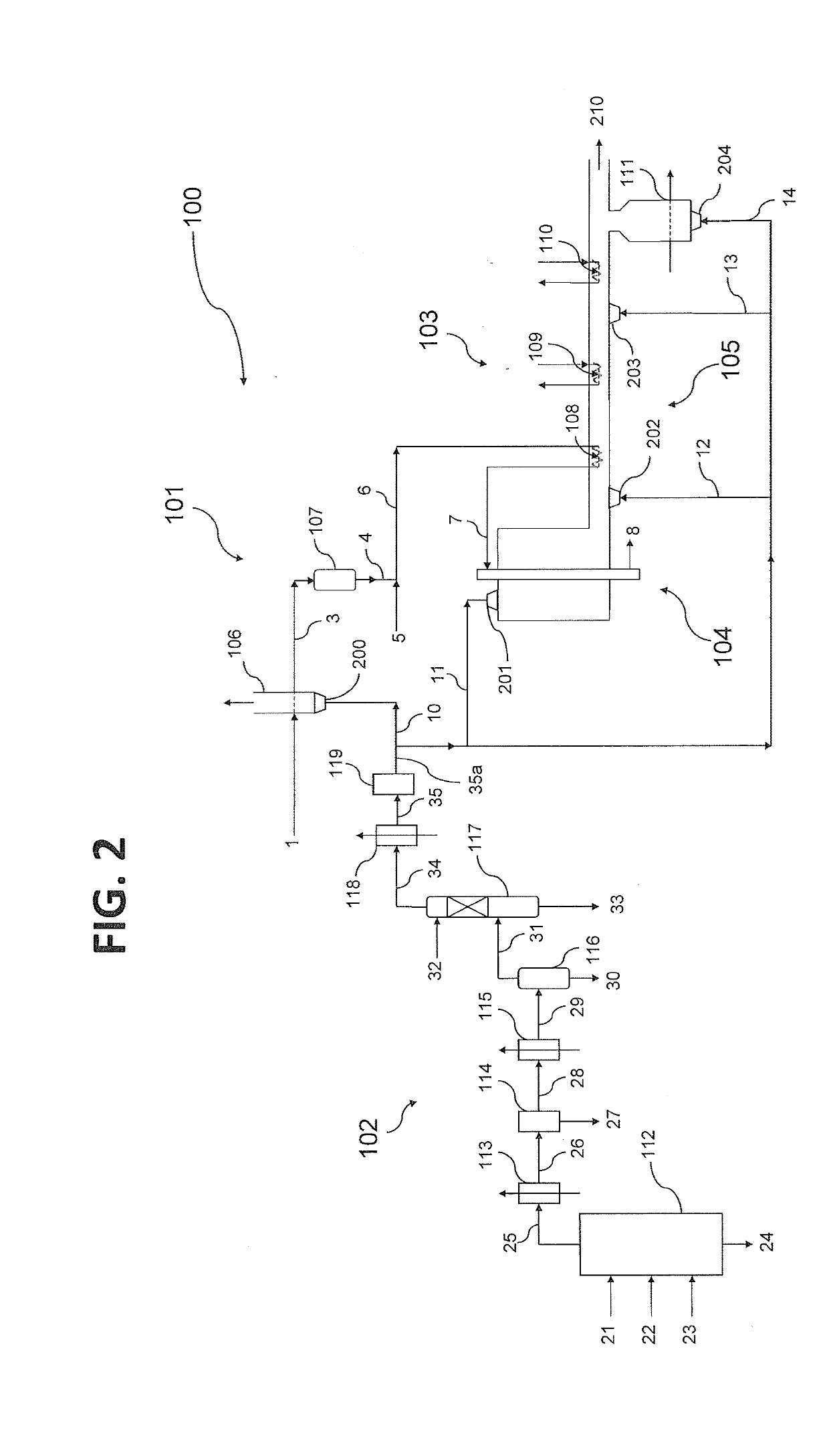Process for producing a synthesis gas
a technology of synthesis gas and process, applied in the direction of hydrogen separation using liquid contact, sustainable manufacturing/processing, separation processes, etc., can solve the problems of increasing the instability of international hydrocarbon markets, limited natural gas quantity, and significant steam in the urea process, so as to reduce the amount of sulphur in the fuel gas, and simplify the sulphur removal techniqu
- Summary
- Abstract
- Description
- Claims
- Application Information
AI Technical Summary
Benefits of technology
Problems solved by technology
Method used
Image
Examples
example 1
[0158]An integrated ammonia / urea plant based entirely on natural gas as feed and fuel produces 2200 tonnes / day of ammonia of which approximately 85% is converted into urea, of which the production is accordingly 3300 tonnes / day. Total energy requirement for the integrated plant, which is completely supplied in the form of natural gas, amounts to 5.2 Gcal LHV basis per tonne of urea product, amounting in total to 715 Gcal / h. Of this total natural gas import, 3.1 Gcal / tonne (426 Gcal / h) is required as process feed for the steam reforming process, with the balance of 2.1 Gcal / t (289 Gcal / h) used as fuel in the steam reformer and for the generation and superheating of high pressure steam. The fuel gas of the steam reformer is a mix of a natural gas stream used as fuel, and a synthesis loop purge gas stream which is a by-product of the natural gas conversion to ammonia. The fuel gas of the steam reformer has the following typical properties: Wobbe Index (WI)=40 MJ / m3.
[0159]The whole natu...
example 2
[0161]An even better result is achieved by combining methanation and bulk CO2 removal, according to another aspect of the invention. The effluent gas from the MDEA desulphurization of Example 1 undergoes a treatment that includes at least a methanation step. The effluent from this treatment has a CH4 concentration of 29% mol, dry basis, and a CO2 concentration of 49% mol, dry basis. After cooling to 40° C. and water condensate separation, the stream is treated in a CO2 PSA for bulk removal of 50% of its CO2 content, achieving a WI=19 MJ / m3 (i.e. 50% of typical value); preferably, the PSA separates 75% of its CO2 content; the gas has then a WI=25 MJ / m3 (63% of the typical value).
[0162]According to another embodiment, the treatment of PSA for bulk CO2 removal could be positioned upstream of the methanation step. In this case, separation of 75% of the CO2 upstream the methanation yields a gas with WI=20 MJ / m3 (50% of the typical value) after cooling to 40° C. and water condensate separ...
example 3
[0163]The plant of example 1 requires a total heat input of 300 Gcal / h. In the conventional ammonia urea complex of example 1, half of the heat (i.e. 150 Gcal / h) is needed for the reformer and half (i.e. 150 Gcal / h) is required for steam generation. As known by those skilled in the art, a typical value of cold gas efficiency of a gasification process is 70%, i.e. the heat value of the gas produced by the gasification is 70% of the heat value of the coal feed.
[0164]The efficiency of a typical gas fired heater (such as a steam reformer or a boiler) is 95%. The efficiency of a typical coal fired boiler is 85%.
[0165]According to another embodiment of the invention, all the heat is provided by combustion of the gas from the gasifier. In this case, the total coal feed is:
coal feed=(total heat input) / (gasifier cold gas efficiency)×(gas fired heater efficiency)=(300) / (0.7×0.95)=450 Gcal / h.
[0166]According to another, preferred embodiment of the invention, the gas produced in the gasifier is ...
PUM
| Property | Measurement | Unit |
|---|---|---|
| temperatures | aaaaa | aaaaa |
| temperature | aaaaa | aaaaa |
| temperature | aaaaa | aaaaa |
Abstract
Description
Claims
Application Information
 Login to View More
Login to View More - R&D
- Intellectual Property
- Life Sciences
- Materials
- Tech Scout
- Unparalleled Data Quality
- Higher Quality Content
- 60% Fewer Hallucinations
Browse by: Latest US Patents, China's latest patents, Technical Efficacy Thesaurus, Application Domain, Technology Topic, Popular Technical Reports.
© 2025 PatSnap. All rights reserved.Legal|Privacy policy|Modern Slavery Act Transparency Statement|Sitemap|About US| Contact US: help@patsnap.com



